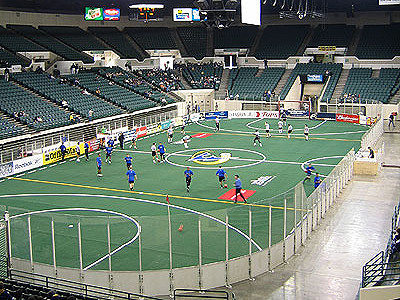Major Indoor Soccer League
|
|
Misl.gif
This article is about the current Major Indoor Soccer League. For information about the 1978-92 MISL see Major Soccer League.
The Major Indoor Soccer League is the only current professional indoor soccer league in the USA. The league is a member of both the United States Soccer Federation and FIFA.
| Contents |
History
In the summer of 2001, the National Professional Soccer League disbanded. The six surviving teams organized the MISL as a single-entity structure similar to Major League Soccer. In 2002, the MISL absorbed two teams from the World Indoor Soccer League, the Dallas Sidekicks and San Diego Sockers. The St. Louis Steamers, another former WISL team, joined the following year.
The current MISL recognizes NPSL history which dates back to 1984 when the NPSL was started as the American Indoor Soccer Association.
Organization
The MISL is currently organized in a single table playing a 40 game schedule. Traditionally, the season begins in October and ends in March. The 2004-2005 season began with 9 teams in 3 division, but San Diego and Monterrey were terminated by the league at midseason. Each teams plays an unbalanced schedule to make up for the lost franchises.
Traditionally, the league also conducts an All-Star Game at midseason. It has pitted Eastern teams against Western teams and USA All-Stars against World All-Stars. No All-Star Game was scheduled for the 2004-2005 season.
The top four teams qualify for the playoffs, which begin in March or April. The first place team faces the fourth place team while the second and third place teams face off. The first round will be a two-game series with a sudden death tie breaker if the teams split the two games. The Championship Series pits the winners of the first round against each other, and was broadcast this year on ESPN2.
MISL Championship series
SEASON CHAMPION SERIES RUNNER-UP 2001-02 Philadelphia Kixx 2 to 1 Milwaukee Wave 2002-03 Baltimore Blast 2 to 1 Milwaukee Wave 2003-04 Baltimore Blast 3 to 0 Milwaukee Wave 2004-05 Milwaukee Wave 2 to 0 Cleveland Force
Teams in the MISL
Active
- Baltimore Blast (2001-present)
- California Cougars (2005-present)
- Chicago Storm (2004-present)
- Cleveland Force (2001-present, as Cleveland Crunch from 2001-02)
- Kansas City Comets (2001-present)
- Milwaukee Wave (2001-present)
- Philadelphia Kixx (2001-present)
- St. Louis Steamers (2003-present)
Expansion/Inactive
- Dallas Sidekicks (2002-2004), inactive for 2004-2005
- Detroit, Michigan (2006)
- Newark, NJ (2007)
Defunct
- Harrisburg Heat (2001-2003)
- Monterrey Fury (2003-2004)
- San Diego Sockers (2002-2004)
Rules
Main article: indoor soccer
The MISL game is the standard North American version of indoor soccer. It is different from the FIFA sanctioned futsal.
Each MISL game consists of four 15 minute quarter. There are breaks between the 1st and 2nd quarter and 3rd and 4th quarter. There is also a 15 minute halftime. Ties result in consecutive 15 minute sudden death overtime.
An MISL field is roughly the size of an hockey rink. It measures 200 feet by 80 feet. Goals measure 14 feet by 8 feet and are set into the boards. Players are allowed to bounce the ball off the dasher boards. Play does stop if the ball leaves the rink.
During an MISL game, each team is allowed to have 6 players on the field at a time. One player is the goalkeeper who may handle the ball while in the penalty arc. The other players are generally divided as two defenders, one midfielder, and two forwards. Substitution is unlimited and may happen "on the fly" during play.
Fouls and misconducts are generally the same as outdoor soccer with a few changes. First, all kicks are direct. Also, the MISL utilizes blue cards in addition to the traditional yellow and red cards of outdoor soccer. Blue and red cards result in a power play for the opposing team. Players would receive red cards may not return to the game. Yellow cards do not result in power plays and generally awarded only for dissent.
Originally, the MISL had a multiple point scoring system where goals were worth 1, 2, or 3 points depending upon the distance that they were scored or game situation. The former WISL teams objected to this. After the 2003 Championship, the league began using a traditional one-point-per-goal rule because of a controversial goal scored during the deciding game.
External link
- MISL (http://www.misl.net)

